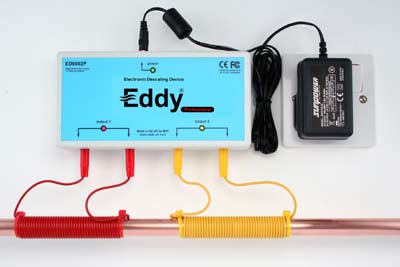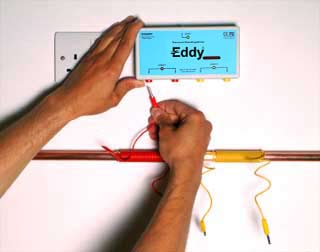Hard water is a common issue for around 60% of UK households, leading to limescale buildup and damaging appliances and heating systems.
To address hard water problems affordably, consider installing the Eddy electronic whole-house descaling device. This simple solution effectively prevents limescale buildup in most homes, offering a cost-effective alternative to traditional chemical water softeners. Find out more below.
The Challenges of Hard Water
Have you encountered any of these limescale-related issues?
- Furred-up kettle with limescale floating on top
- Clogged shower head
- Slow hot taps from clogged pipes
- Stubborn tidemarks around baths and sinks
- White stains on taps
- Rising heating costs from an inefficient boiler
- Scummy film on tea or coffee
- Spotty deposits on shower enclosures
- Scratchy towels and clothing
All these are signs of hard water, leading to premature failure of water-using appliances.
To keep appliances functional, they require regular descaling, in most cases adding to an already hectic household schedule.
Ignoring proper maintenance of heating systems can lead to costly consequences, including inefficiency, breakdowns, and potential boiler damage, necessitating costly repairs and even replacement.
Where are Hard Water Areas in the UK?
Due to geological factors found within the South and East of the UK such as the presence of quantities of limestone and chalk, these areas are subject to hard water issues. This is also the case for large parts of the Republic of Ireland. On the flip side to this, the North and West are soft water areas.
To learn more about hard water presence in the UK, see ourdealing with hard water project.
What’s the Solution to Hard Water?
Dealing with hard water and its limescale aftermath can be tackled through various methods:
- Chemical Cleaners: Regular use of chemical limescale cleaners requires continuous scrubbing. This approach is not only costly but also harms the environment due to polluted waste water.
- Conventional Water Softeners: Installing ion exchange water softeners is the priciest option, with upfront costs up to £1100 plus installation fees. These systems require plumbing into the mains water supply and consume significant amounts of salt, adding around £12 per month for a family of four. They also create a lot of waste water. Additionally, softened water from these devices contains elevated sodium levels, unsuitable for drinking. This necessitates separate drinking water sources, especially crucial for households with children or infants.
- Electronic or Magnetic Descalers: These devices, like the Eddy Water Descaler, utilise electronic technology or powerful magnets to inhibit limescale formation in pipes and appliances. Unlike conventional softeners, descalers don’t replace calcium with sodium, offering a more practical solution.
For further details, see our project on types of water softeners and conditioners.
Understanding the Eddy Water Descaler
The Eddy Water Descaler, devised by Surrey-based manufacturers, originated in 1999, created by two London-based electronic engineers who shared a frustration with hard water issues at home. They aimed to develop a cost-effective solution matching the effectiveness of pricier water softeners, emphasising local production and environmental sustainability.
The current flagship model, the Eddy ED6002P, debuted in 2006, garnering ongoing acclaim for its performance. Unlike salt-based softeners, Eddy’s eco-friendly design ensures no harmful discharge into wastewater.
But how does it function? By encircling coils of wire around the main water pipe, the Eddy Descaler generates a magnetic field through the water, preventing calcium from depositing on fixtures like taps and kettles.
While some competitors’ devices falter due to low output signals, Eddy’s dual-coil system ensures prolonged exposure to the magnetic field, enhancing efficacy. The device’s British origin and 12-month money-back guarantee bolster its ongoing reputation.
Eddy Water Descalers offer an affordable, environmentally friendly remedy for limescale issues, maintaining water’s chemical integrity and safety for consumption. After installation, limescale accumulation diminishes notably, benefiting both visible and concealed areas like heating elements, thereby reducing energy costs and appliance damage. Installation is user-friendly, typically taking around 30 minutes, making it an accessible solution for households grappling with hard water problems.

Fig.1 Eddy Electronic Descaling device fully installed on an incoming copper water main.
Tools and Products Needed for Installing the Eddy Water Descaler
To install the Eddy Water Descaler you will need the following tools and products:
- An Eddy Water Descaler kit
- Medium grit sandpaper (to clean copper or iron pipes if slightly corroded)
- Household cleaner (clean surface before sticking unit to wall)
- Cleaning rag
- Drill/driver with screwdriver attachments (if you need to remove the rear of any units to access pipes)
Installing the Eddy Water Descaling System
Installing the Eddy descaling unit is a breeze and can be done as a DIY project. Just follow these simple steps to get started and experience the benefits of reduced limescale buildup:
Important Note: The Eddy descaler is compatible with copper, iron, and plastic pipes. However, it’s recommended not to install it on lead pipes. Removing limescale from lead pipes can expose your water supply to harmful lead contamination.
- Find the incoming cold water main, typically under the sink or in the under stairs cupboard. It’s usually a 15mm or 22mm copper pipe with a nearby stopcock. Refer to Fig.2 for an example.
- Select a suitable part of the pipe, at least 23cm (9 inches) long, to wrap the two coils of wire around. Ensure there’s space on the wall nearby (within 8 inches) to attach the main Eddy device so it’s reachable from the coils, once wound on to the pipe.
- Choose an installation spot close to the incoming supply, before any branches off the pipe. If the water main splits upon entering your property, wrap one coil around each pipe instead of both around a single pipe.
- Wrap the two wire coils around the pipe tightly as per the Eddy installation manual (refer to Fig.3). Secure each end tightly using the small colour-coded zip tie included in the kit.
- Fix the Eddy Water Descaler main unit to the wall within reach of the coils using the provided heavy-duty self-adhesive Velcro. Plug the coils into the unit (see Fig.4).
- Find a mains socket within a reasonable distance of the Eddy unit for connecting the power cable via the provided mains adapter. Use an extension lead if necessary, ensuring the mains socket/power adapter stays away from any damp areas.
- Switch on and bid farewell to limescale for a cost of no more than 10p per week!

Fig.2 Typical location of incoming water main

Fig.3 Coils wound onto mains water pipe

Fig.4 Fixing Eddy to wall and plugging in
Over the years we have installed the Eddy Water Descaler in numerous homes and on the whole, have found it to be an effective tool in reducing limescale buildup within domestic properties.
Current price of the Eddy electronic water descaler is £149.99 and is available direct from manufacturer or from various other outlets online.
For further information on electronic limescale prevention go to the Eddy website: www.eddy.uk.com.
email admin@eddy.uk.com or telephone Eddy Water Descalers on 020 8287 6668

